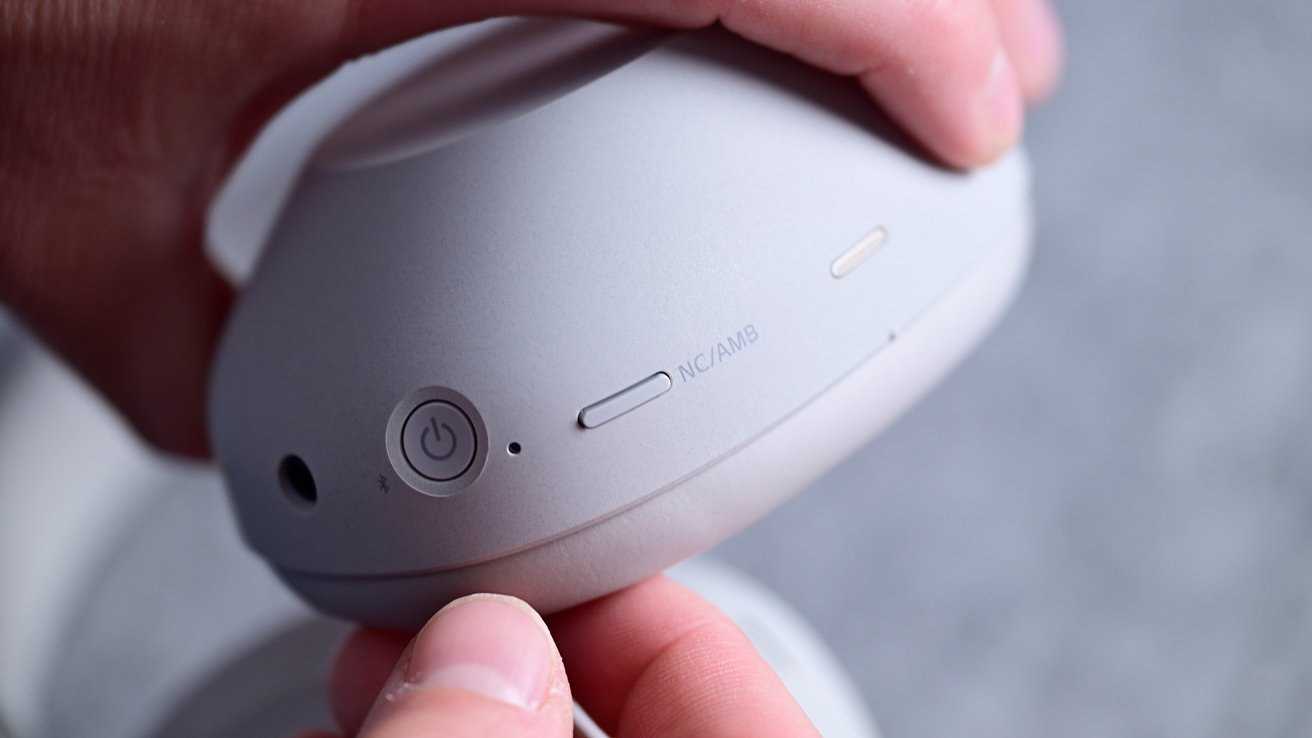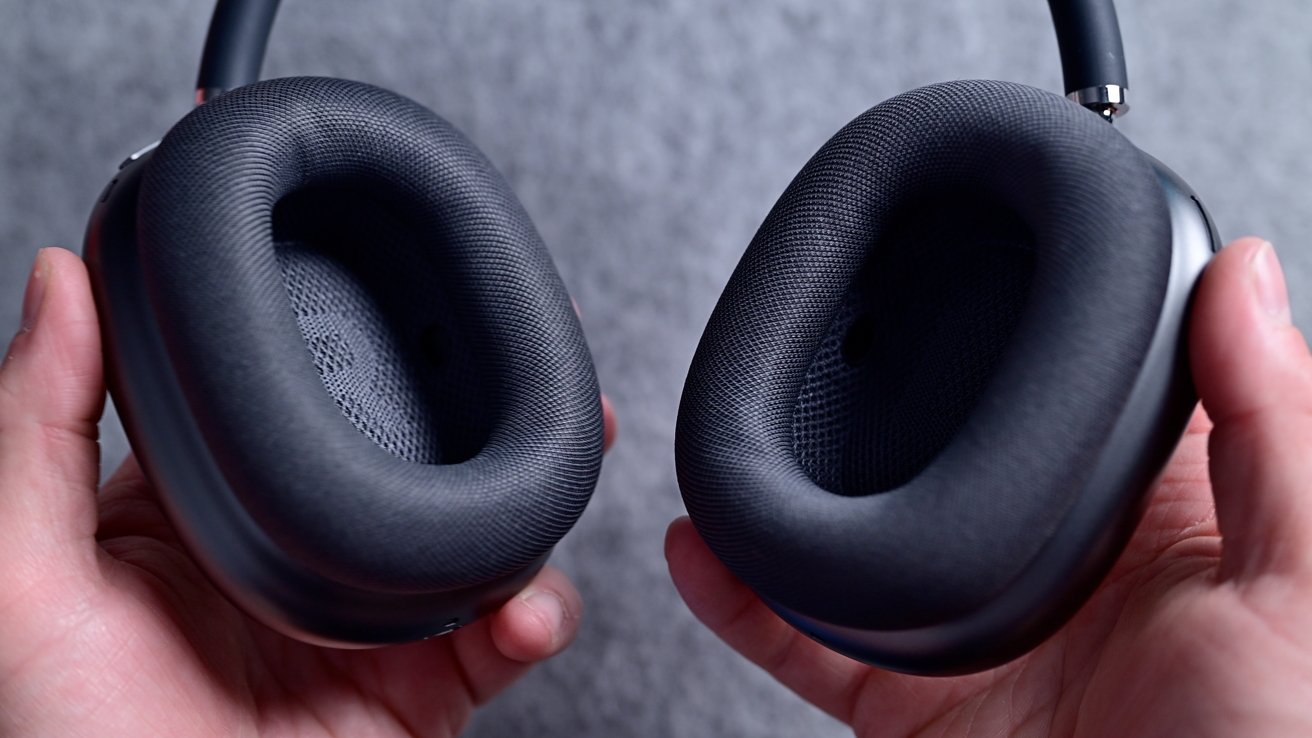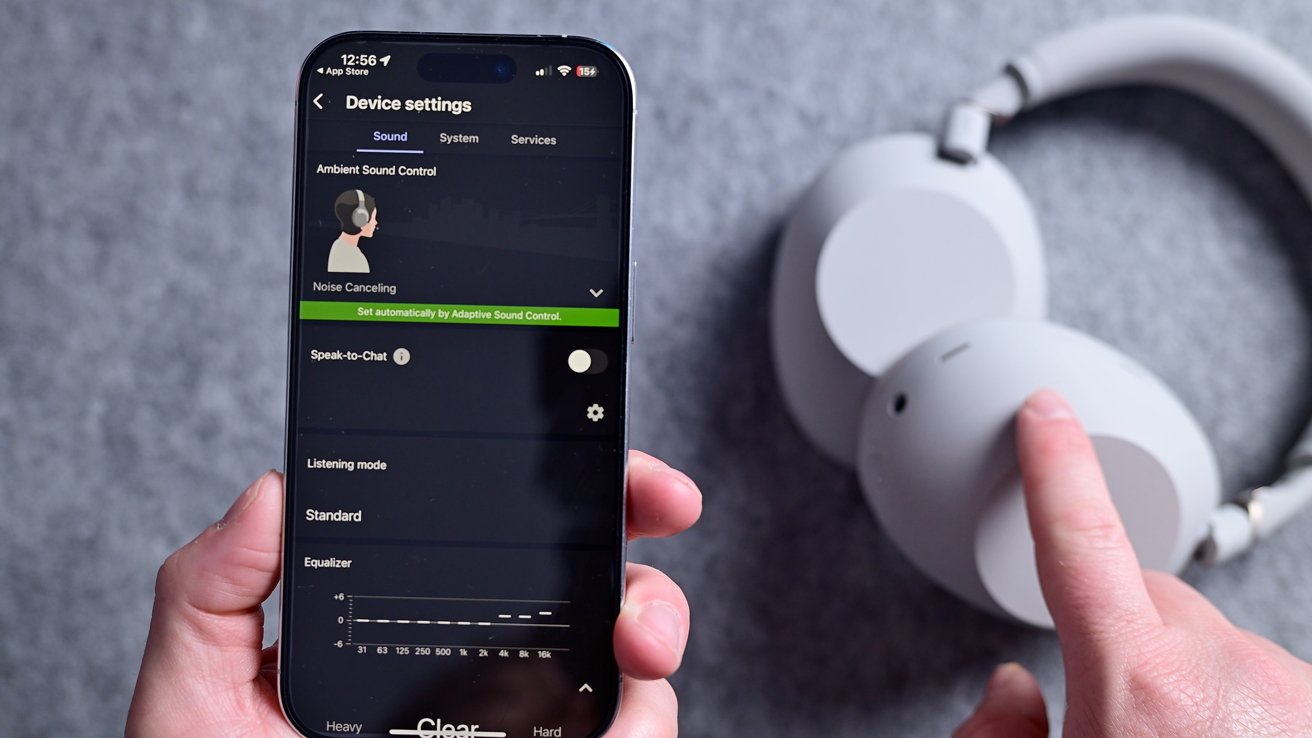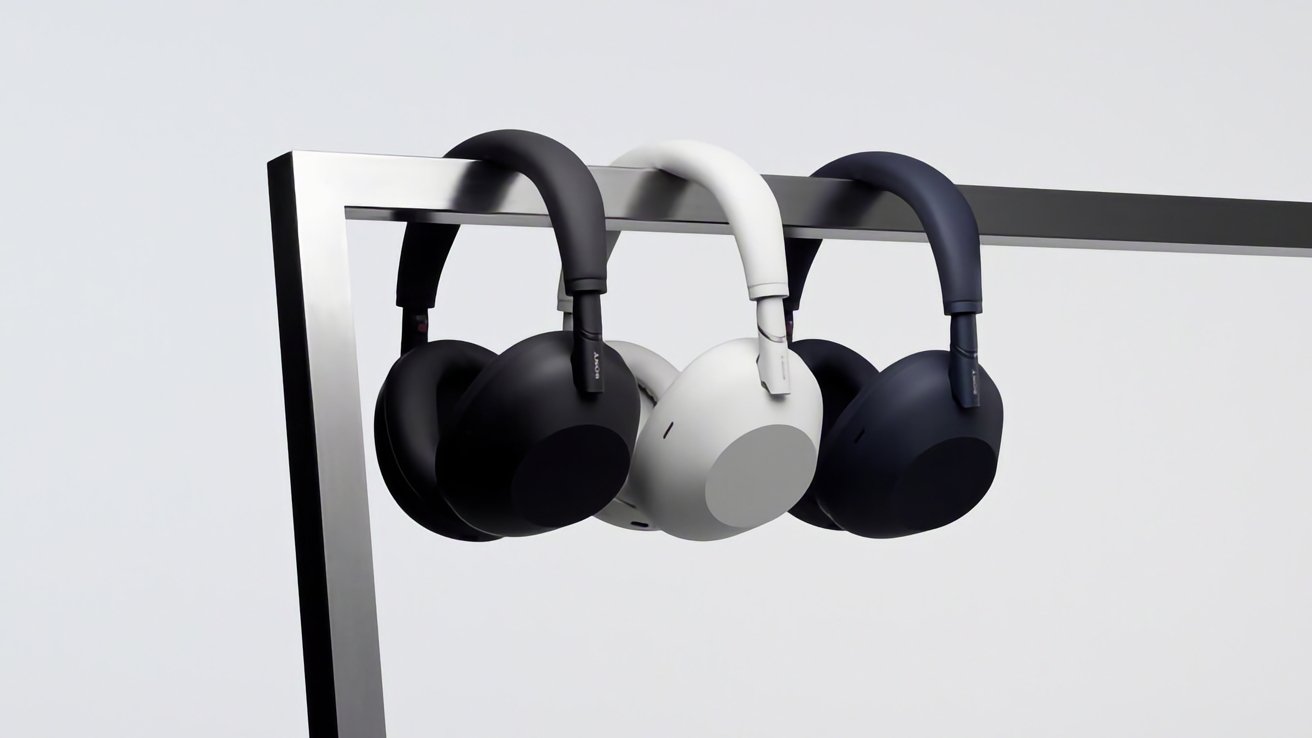AirPods Max vs Sony XM6 - Over-ear headphones shootout
Announced on May 15, Sony's WH-1000XM6 are premium over-ear headphones with ANC, which improves upon its predecessor. Here's how they compare to Apple's AirPods Max.

AirPods Max vs Sony WH-1000XM6 - Both sets of ANC headphones
The premium headphone market has a few companies at the top, and Sony is one of them. Its headphone heritage is extensive, with its XM4 offering good quality at a price $200 cheaper than the AirPods Max.
The Sony WH-1000XM5 were a revision that more directly competed with the AirPods Max, and was very well received in 2022. Now, Sony has continued the line with the WH-1000XM6, this time boasting highly improved active noise cancellation.
In a rematch three years in the making, here's how Sony's latest ANC headphones compare against Apple's long-standing AirPods Max.
AirPods Max vs Sony WH-1000XM6 - Specifications
| Specifications | AirPods Max | Sony WH-1000XM6 |
|---|---|---|
| Price | $549 On sale at Amazon | $449.99 On sale at Amazon |
| Weight | 13.6 ounces | 8.96 ounces |
| Foldable | No | Yes |
| Drivers | 40mm | 30mm |
| Noise Cancellation | Yes | Yes |
| Spatial Audio | Yes | Yes |
| Charging port | USB-C | USB-C |
| Battery Life | 20 hours ANC on | 30 hours ANC on |
| Controls | Digital Crown, Button | Buttons |
| Colors | Silver, Space Grey, Sky Blue, Pink, Green | Black, Platinum Silver, Midnight Blue |
AirPods Max vs Sony WH-1000XM6 - Design
Apple's design for the AirPods Max hasn't changed at all over the years, except for one connector. It's a stainless steel headband wrapped in rubber, with a canopy cushion at the top.
The aluminum earcups of the AirPods Max are matched by a mesh textile-covered foam for comfort. It's a thoroughly premium design, but one that can lie flat, if not fold.
The Sony XM6 follow the same sort of design philosophy as the previous generation, but this time, Sony has gone for a wider headband made with synthetic leather. The earpads are made from a stretchy material intended for all-day wear, with the earcups neatly swiveling into position.

AirPods Max vs Sony WH-1000XM6 - The Sony XM6 headphones in their carrying case
You don't get the shiny exposed metal of the AirPods Max here, as Sony prefers a uniform appearance here. Aside from some highlights like the Sony logo, of course.
When it comes to weight, the XM6 are pretty similar to the last generation at 8.96 ounces. Once again, this is positively lightweight compared to the 13.6-ounce AirPods Max.
Sony does, however, allow the latest edition to fold up. This makes the XM6 much better from a portability and storage perspective, and a bit better for travel.
AirPods Max vs Sony WH-1000XM6 - Control
When it comes to physical controls, the two headphones go down slightly different routes. Sony opts for a large power button and a smaller NC/AMB button, while Apple relies on a Digital Crown and a noise control button for flexibility and minimalism.
Beyond these, the two headphones also rely on a bunch of other ways to manage your music and audio needs. There's also a lot of crossover here.
Sony has a dedicated app that can be used to fine-tune the earphones to your listening needs. Apple offers something similar within iOS itself for the AirPods Max, thanks to its deep integration.

AirPods Max vs Sony WH-1000XM6 - Power and ANC button on the Sony XM6
Both are capable of playing and pausing music when put on or taken off. This is handy for preserving battery life or for halting playback temporarily.
One area where the AirPods Max lose out is gestures, as you can nod or shake your head with the XM6 to answer or decline calls, for example.
Both also have the ability to work with connected digital assistants like Siri and Google Assistant, which adds another layer of control.
AirPods Max vs Sony WH-1000XM6 - Audio Processing
Premium headphones require premium features, and both examples here offer just that.
AirPods Max is known for active noise cancellation, with Apple also including Transparency Mode using its array of microphones. There are nine in total, with eight used for ANC and two ANC mics used with the spare for voice pickup.
It also handles things like Personalized Spatial Audio with dynamic head tracking, and an adaptive EQ. All of this is driven by the H1 chip included in each earcup.

AirPods Max vs Sony WH-1000XM6 - Earcups for AirPods Max that house the 40mm drivers
For the XM6, Sony includes an upgraded ANC system. The new HD Noise Cancelling Processor QN3 is said to be seven times faster than the previous generation, with it also adding more microphones for ANC, with a total of 12 in use.
The noise cancellation is also optimized in real-time, thanks to the Adaptive NC Optimizer.
An Auto Ambient Sound model is able to adapt to the user's surroundings, offering a balance of music and environmental sounds similar to Transparency Mode. However, Sony does allow you to adjust the settings within its Sound Connect app.
Pumping sound into the ears is Apple's custom 40mm dynamic drivers. Sony goes for a 30mm version, which it also says is optimally tuned for noise cancellation purposes.
Sony also created a carbon fiber composite material dome and its own voice coil structure for improved vocal reproduction.
For audio pickup, the XM6 uses a six-microphone array with an AI-based beamforming system. Sony says this helps improve voice isolation.
AirPods Max vs Sony WH-1000XM6 - Audio and ANC Quality
Despite the AirPods Max's unuqdated audio components, they still sound incredibly good. In our testing, the AirPods Max just edge out the still-excellent Sony XM6.
Specifically, the mids on AirPods Max are a bit more clear. This is more true on instrumental music where they also sound more true to life compared to synth-heavy modern tracks.
Additionally, AirPods Max still have an incredibly-large soundstage. The audio sounds like it is coming from all around versus sounding more constrained a bit on the XM6.
The soundstage is very important when it comes to other features too, like Spatial Audio with head tracking. The audio has more room and separation for a more convincing effect.
Sony does have the edge when it comes to customization though. While Apple prioritizes accuracy, Sony offers a companion app with a built-in equalizer.

AirPods Max vs Sony WH-1000XM6 - The Sony companion app for the XM6 headphones
Users are able to tune the headphones to their liking. That way you can amp up the bass or make it more level, depending on your preferences.
If you are particular in a certain sound profile, the Sonys may be better since you can dial them in. Apple doesn't allow for such granular customization.
For noise cancellation, AirPods Max continue to be best-in-class. We found the Bose QuietComfort were still superior overall, but between the Sony XM6 and AirPods Max, the latter were better.
Slightly more ambient noise came through in our simulated test in the studio, playing loud airplane-mimicking white noise through a series of surround speakers.
Again, both of these are very good and we're getting into the nitty gritty. We'd happily listen to either of these headphones for hours on end without any complaints on the audio or ANC quality.
AirPods Max vs Sony WH-1000XM6 - Connectivity and Battery Life
Physical connectivity is handled by USB-C on both headphones, with Sony also adding a headphone jack.
On the wireless side, Apple uses Bluetooth 5.0 to connect to its hardware. Apple's use of iCloud and Apple ID makes it so the AirPods Max can switch easily between Apple devices.
A firmware update worked with iOS 18.4 enabled lossless audio and ultra-low-latency audio in the AirPods Max.
Sony includes multi-point connection, including support for two Bluetooth devices at the same time over Bluetooth 5.3. There's easy pairing available with Windows 11 and Windows 10 PCs, along with Fast Pair on Android devices.
It's also claimed that the XM6 are ready to work with LE Audio, allowing the headphones to enter a low-latency mode for gaming. Support for Auracast is also available for public broadcasts.
When it comes to battery life, the AirPods Max offer up to 20 hours of listening from a single charge with ANC and Spatial Audio enabled. Fast-charge is available, with 1.5 hours generated from five minutes of charging.
Sony claims it can last for up to 30 hours from a single charge with ANC on, but that stretches to 40 hours with ANC off.
AirPods Max vs Sony WH-1000XM6 - One upgrade, one in waiting
It's safe to say that the Sony WH-1000XM6 and the AirPods Max are great examples of premium audio, if you can afford them.
Sony's newest update to the line brings with it a folding design, beefier onboard processing, improved ANC, and the capability to fine-tune the settings. If you have a multi-ecosystem computing environment, they would fit in pretty well almost anywhere.
AirPods Max, meanwhile, is still arguably the best option if you're entrenched in the Apple ecosystem completely. The integration with Apple's operating system makes it a better choice in that situation.

AirPods Max vs Sony WH-1000XM6 - The XM6 color range
For previous generations, we would've pointed out how much cheaper the Sony headphones were compared to the AirPods Max. However, at $449 for the XM6 and with AirPods Max hitting $480 when discounted, the price is no longer an advantage Sony can lean on.
What is evident, though, is that Sony's willing to rethink its premium headphones at a much faster rate than Apple. In two years, it's updated quite a few bits of its headphones for the better.
Apple, meanwhile, has barely made any material changes to the AirPods Max since its launch in late 2020. The addition of USB-C instead of Lightning for charging is nice, but not entirely groundbreaking.
That said, with Apple's lossless and low-latency firmware update earlier in 2025, it shows there's still some room to grow for the AirPods Max, over four years after release.
Where to buy the Sony XM6 vs AirPods Max headphones
Sony's XM6 over-ear headphones retail for $449, with Amazon and B&H accepting orders for the 2025 release.
Apple's AirPods Max, meanwhile, are regularly on sale, with Amazon discounting the USB-C headphones to as low as $479.99 at press time (down from $549). You can check out our AirPods deals coverage and compare prices across popular resellers in our AirPods Price Guide.
Read on AppleInsider


Comments
What HiFI got a headset from Sony and to answer your question:
https://www.whathifi.com/headphones/sony-wh-1000xm6
Nothing compares to putting the headphones on your head, adjusting them for a comfortable fit that you can tolerate for extended listening sessions, and listening to actual music that is at least characteristically similar to what you enjoy listening to. If you can repeat the same subjective evaluation for different sets of headphones you're considering, all the better. Every head is different, every ear is different, every person's hearing frequency response is different (and changes with age), and every person's brain and emotions reacts to sound in a unique way.
I'm not suggesting that headphone evaluator's listening experiences and reactions are invalid, but they are always subjective and in many cases are more discerning. The higher you go in the range of audiophile hierarchy the more the terminology spoken or written about becomes more like a foreign language to a lot of people who are in the market for a new set of headphones, like me. No matter what anyone says sounds better or worse is only their opinion, but the only opinion that matters is your own. If you have a history with a particular reviewer who has helped you based on his or her subjective opinion, that can be helpful as a filtering process. It's no guaranteed but it's not totally random either.
Articles like this one do help you narrow down the list of candidate products based on objective visible, touchable, and measurable differences. No more and no less. It's a great step in the right direction. I'm not going to say that someone else's opinion of what sounds good or what sounds bad does not matter because it is a data point to consider. I've bought $30 headphones that delivered a far more enjoyable listening experience than $300 headphones. This is why I'm wary of buying any product that has so many dependencies on my subjectivity without the option of trying it myself or having the ability to send it back if it doesn't meet my expectations. In a lot of ways the old brick & mortar experiences were actually much better than the YouTube, blog, online articles, or Amazon review based ones are.
https://www.soundguys.com/apple-airpods-max-review-44975/
https://www.soundguys.com/sony-wh-1000xm6-review-137397/
The XM6 like the XM5 has 30mm drivers, XM4 has 40mm and some reviews rank it higher for sound quality. Smaller drivers tend to produce weaker sound, especially weaker bass but some people prefer the sound clarity with weaker bass. Airpods Max has 40mm drivers like most premium over-ear headphones.
https://versus.com/en/headphone?filter%5B%5D=driver_unit=30,90
This is mentioned in this review:
https://www.cnet.com/tech/mobile/sony-wh-1000xm6-review-hail-to-the-new-noise-canceling-king/
"When Sony moved from the XM4 to the XM5, it went from using 40mm drivers to 30mm drivers, which changed the sound fairly dramatically, and not everyone liked the change. The XM4, which remains available, is a warmer headphone with bigger, more energetic bass, while the XM5 offers more detailed sound and tighter bass.
Sony has touted how it had some exceptionally accomplished sound engineers in New York tune the headphones, and I spoke with one of them before the launch of the headphones. He said the stiffest competition for sound quality came from the AirPods Max, and I tend to agree with that, although I also think the Sonos Ace is quite competitive. However, I liked the midrange on the Sony slightly better, and the bass has a little more kick to it. With tracks that had very deep bass, the Sony resolved the lows with aplomb and sounded quite consistent."
The main things reviewers said against the Airpods Max were weight and price but sound quality and noise-cancelling were rated as high as competing headphones and probably why they haven't brought out a 2nd model yet as there's little to improve in terms of sound quality.
Max is also too heavy something Apple should address. As for NC the XM6 is by reviewers seen as superior. And the case... Apple should have create a new case years ago. XM6 is reported to charge for 3 hours in 3 minutes while Max is capable of 1 hour in 5 minutes. There are plenty of reasons for doing a proper update.
Preferably launch Max 2 with Bluetooth 6 and a better audio codec at the same time as iPhone 17 Pro.
But calling a comparison a "shootout" really should include details about audio quality. Any overall conclusions can obviously be shaped by subjective interpretation of audio characteristics. But there are audio characteristics/details which can be observed and reported with a level of objectivity. Things like audio roll off at earlier then typical frequencies or overly bright, or grittiness of symbols instead of a sheen etc. Muddiness in the midrange. How important any anomalies are to any one user would be the subjective part.
That being said I still prefer the Max. I've been on my original pair since the end of 2021.
Keep in mind that it is a target frequency response curve. Very hard to hit the target exactly. There are many design variables at play even if you wanted to hit it exactly. Over or in-ear design, size of the drivers, cost of materials etc. Assuming we're talking about legit audio companies that desire to make good sounding products, you can have every manufacturer trying to design for that target frequency response curve but the results are different because of the compromises/choices that needed to be made for that particular headphone. Every designer will make different choices resulting in different sounding headphones.
What's my definition of compelling audible advancement? That's an easy one. AirPods Pro 2 vs AirPods Pro 1. I still have both and the difference in sound quality and ANC is night and day.